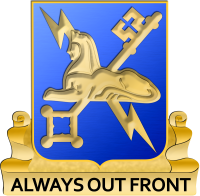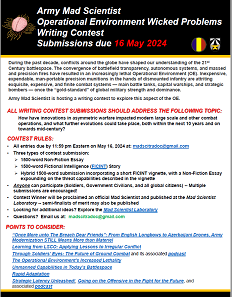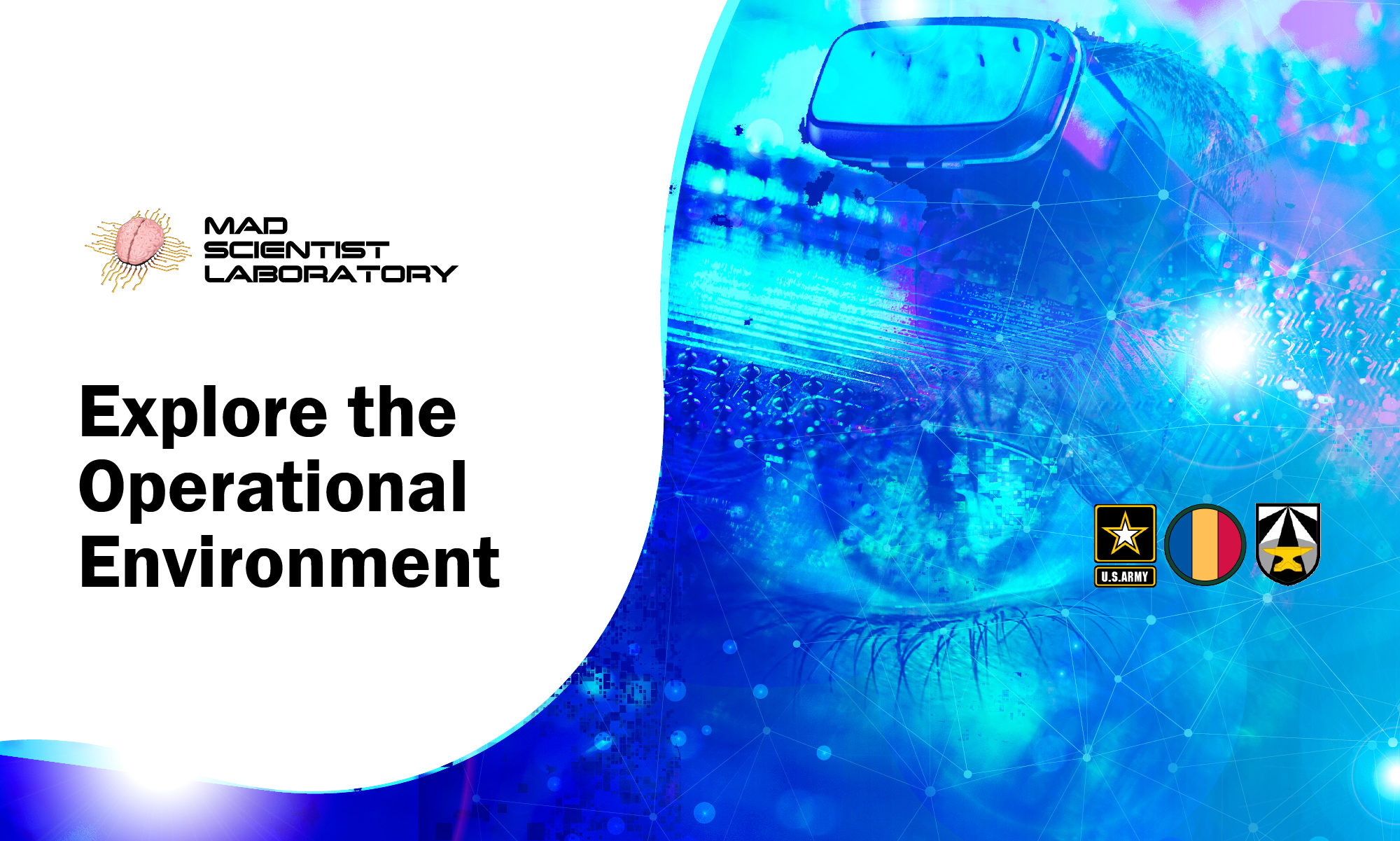“OSINT should be the ‘INT’ of first resort.”
[Editor’s Note: The TRADOC G-2 appreciates the value of Open-Source Intelligence (OSINT) in informing us about emergent trends across the Operational Environment (OE). For almost two years, analysts within the G-2 ACE collated insights on Russia’s on-going “Special Military Operation” in Ukraine to learn about the contemporary Russian way of war, understand how they were adapting and innovating across enduring Large Scale Combat Operations, and identify potential ramifications for U.S. Army modernization across DOTMLPF-P. The associated weekly “scrum” methodology generating weekly TRADOC Running Estimates and associated Narratives is described in greater detail in this Red Diamond article.
Beginning in January 2024, the G-2 ACE adapted this methodology to address its FY24 Program of Analysis key intelligence questions spanning the OE and conducted bi-weekly “scrums” to generate monthly OE Running Estimates and associated Narratives, and quarterly OE Assessments.
Each of these weekly TRADOC Running Estimates and monthly OE Running Estimates were “synchronized” with corresponding classified products prior to their publication to ensure the highest fidelity and accuracy in OE reporting. Capturing these insights has proven invaluable in the G-2 describing the evolving OE — foundational to TRADOC’s mission of training Soldiers and supporting unit training; developing adaptive Leaders; guiding the Army through doctrine; and shaping the Army by building and integrating formations, capabilities, and materiel. Links to our archives of these TRADOC and OE Running Estimates may be found at the end of this blog post.
In today’s episode of The Convergence Podcast, Army Mad Scientist sits down with Shawn Nilius, Director, Army OSINT Office, to discuss why OSINT is important to the Army, how it is being used in contemporary operations, and how he sees it evolving over the next 10 years — Enjoy!]
[If the podcast dashboard is not rendering correctly for you, please click here to listen to the podcast.]
 Mr. Shawn M. Nilius was appointed Director, Army Open-Source Intelligence (OSINT) Office in March 2022. The Army OSINT Office (AOO) serves as the OSINT operational support lead for Army OSINT and provides technical oversight, compliance, management, and governance of open-source activities while synchronizing resourcing and requirements across the Army Intelligence and Security Enterprise (AISE). Prior to becoming a Department of the Army civilian, Mr. Nilius served as a career Army Military Intelligence Officer, whose previous assignments included Director of Intelligence (G-2), U.S. Army Africa; Director, Combined Joint Intelligence Operations Center, U.S. Forces Afghanistan, Kabul, Afghanistan; Director, Joint Intelligence Center Special Operations Command, U.S. Special Operations Command, Tampa, Florida; and Director of Intelligence (J-2), U.S. Forces – Iraq, Baghdad, Iraq. Mr. Nilius has a Masters of Science, Strategic Studies, U.S. Army War College, Carlisle Barracks, Pennsylvania; a Masters of Science, Strategic Intelligence-Middle Eastern Studies, National Intelligence University, Washington, DC; and a Bachelors of Arts, Political Science, Iowa State University, Ames, Iowa.
Mr. Shawn M. Nilius was appointed Director, Army Open-Source Intelligence (OSINT) Office in March 2022. The Army OSINT Office (AOO) serves as the OSINT operational support lead for Army OSINT and provides technical oversight, compliance, management, and governance of open-source activities while synchronizing resourcing and requirements across the Army Intelligence and Security Enterprise (AISE). Prior to becoming a Department of the Army civilian, Mr. Nilius served as a career Army Military Intelligence Officer, whose previous assignments included Director of Intelligence (G-2), U.S. Army Africa; Director, Combined Joint Intelligence Operations Center, U.S. Forces Afghanistan, Kabul, Afghanistan; Director, Joint Intelligence Center Special Operations Command, U.S. Special Operations Command, Tampa, Florida; and Director of Intelligence (J-2), U.S. Forces – Iraq, Baghdad, Iraq. Mr. Nilius has a Masters of Science, Strategic Studies, U.S. Army War College, Carlisle Barracks, Pennsylvania; a Masters of Science, Strategic Intelligence-Middle Eastern Studies, National Intelligence University, Washington, DC; and a Bachelors of Arts, Political Science, Iowa State University, Ames, Iowa.
In our latest episode of The Convergence podcast, Army Mad Scientist sat down with Shawn Nilius, Director, Army OSINT Office, to learn what OSINT is, how it is collected, and how it is having an impact on current conflicts. The following bullet points highlight key takeaways from our conversation:
-
-
- OSINT is not the same as Publicly Available Information (PAI). Around 85% of the information available worldwide is PAI – this includes content on the internet.
 However, the general population spends most of their time being exposed to only 4% of the entirety of the internet – the tip of the iceberg. Below the surface, in the deep and dark web, is where the Army goes to counter nefarious actors.
However, the general population spends most of their time being exposed to only 4% of the entirety of the internet – the tip of the iceberg. Below the surface, in the deep and dark web, is where the Army goes to counter nefarious actors.
- OSINT is not the same as Publicly Available Information (PAI). Around 85% of the information available worldwide is PAI – this includes content on the internet.
-
-
-
-

OSINT among the other INTs / Source: RAND Corporation image via Military Intelligence Not everyone can collect OSINT. Only intelligence professionals with an assigned mission, authorities, and a collection requirement from the Commander can retrieve open-source information and process it into finished intelligence.
-
-
-
-
- Training intelligence professionals in OSINT collection is vital. The Army was the first service to put OSINT training into the training program at the
 Intelligence Center of Excellence. After completion, collectors are given a set of ‘tools’ to use on the open internet to aid in their search. The Army OSINT office also monitors all collectors’ actions to ensure compliance with guidance, rules, and applicable laws.
Intelligence Center of Excellence. After completion, collectors are given a set of ‘tools’ to use on the open internet to aid in their search. The Army OSINT office also monitors all collectors’ actions to ensure compliance with guidance, rules, and applicable laws.
- Training intelligence professionals in OSINT collection is vital. The Army was the first service to put OSINT training into the training program at the
-
-
-
- OSINT is not new, but changes in the character of warfare have impacted OSINT collection – predominantly the increase in the speed of the battlefield.
 Recent conflicts have shown that information from the battlefield can be communicated in near real-time. For example, the Russian invasion of Ukraine was first shown through a civilian with a cellphone live-streaming the Russian tanks crossing the border – publicly available information, captured by a collector, and turned into intelligence.
Recent conflicts have shown that information from the battlefield can be communicated in near real-time. For example, the Russian invasion of Ukraine was first shown through a civilian with a cellphone live-streaming the Russian tanks crossing the border – publicly available information, captured by a collector, and turned into intelligence.
- OSINT is not new, but changes in the character of warfare have impacted OSINT collection – predominantly the increase in the speed of the battlefield.
-
-
-
-

Little Green Men at Simferopol Airport in Ukraine’s Crimea peninsula, 2014 / Source: VOA, Photo by Elizabeth Arrott Misinformation and disinformation will flood a collector’s search. Properly trained, they will be able to identify fact from fiction. Early in the Russia-Ukraine conflict, video surfaced online of troops parachuting into the battlefield, purporting to be a recent development. A seasoned OSINT collector correctly identified the video as footage from the 2014 annexation of Crimea.
-
-
-
-
- OSINT should be the ‘INT’ of first resort. The speed at which it can be collected, processed, exploited, and disseminated means that it should
 be used to ‘tip’ or ‘cue’ the other INTs early in the planning and operations stages. The Army can use OSINT to quickly and effectively orient their decision making in the right direction to ultimately achieve information advantage.
be used to ‘tip’ or ‘cue’ the other INTs early in the planning and operations stages. The Army can use OSINT to quickly and effectively orient their decision making in the right direction to ultimately achieve information advantage.
- OSINT should be the ‘INT’ of first resort. The speed at which it can be collected, processed, exploited, and disseminated means that it should
-

Stay tuned to the Mad Scientist Laboratory for our next episode of The Convergence on 30 May 2024, featuring LtCol Erik Keim (USMC) discussing the Future Dynamics of Warfare project he and his AWC classmates collaborated on, his research on blending in the electromagnetic spectrum, and how the Army can adapt to the modern battlefield.
If you enjoyed this post, check out our series of blog posts exploring what we’re learning about the Operational Environment:
Unmanned Capabilities in Today’s Battlespace
The Operational Environment’s Increased Lethality
WMD Threat: Now and in the Future
The Hard Part of Fighting a War: Contested Logistics
Revolutionizing 21st Century Warfighting: UAVs and C-UAS
Explore the TRADOC G-2‘s Operational Environment Enterprise web page, brimming with information on the Operational Environment (OE) and how our adversaries fight, including:
Our China Landing Zone, full of information regarding our pacing challenge, including ATP 7-100.3, Chinese Tactics, BiteSize China weekly topics, People’s Liberation Army Ground Forces Quick Reference Guide, and our thirty-plus snapshots captured to date addressing what China is learning about the Operational Environment from Russia’s war against Ukraine (note that a DoD Common Access Card [CAC] is required to access this last link).
Our Russia Landing Zone, including the BiteSize Russia weekly topics. If you have a CAC, you’ll be especially interested in reviewing our RUS-UKR Conflict SharePoint site’s weekly TRADOC Running Estimates and associated Narratives, capturing what we learned about the contemporary Russian way of war in Ukraine over the past two years and the ramifications for U.S. Army modernization across DOTMLPF-P.
Our OE Running Estimates SharePoint site (also requires a CAC to access), containing our monthly OE Running Estimates, associated Narratives, and the 2QFY24 OE Assessment TRADOC Information Paper (TIP).
Read the following related Mad Scientist Laboratory posts:
Democratized Intelligence and Russia-Ukraine Conflict: Sign Post to the Future (Part 1), by Kate Kilgore
Insights from Ukraine on the Operational Environment and the Changing Character of Warfare
Learning from LSCO: Applying Lessons to Irregular Conflict, by Ian Sullivan and Kate Kilgore
Weaponized Information: What We’ve Learned So Far…, Insights from the Mad Scientist Weaponized Information Series of Virtual Events, and all of this series’ associated content and videos
China and Russia: Achieving Decision Dominance and Information Advantage, by Ian Sullivan
>>>>DEADLINE FOR SUBMISSION IS MIDNIGHT TONIGHT!!!<<<< Army Mad Scientist wants to crowdsource your thoughts on asymmetric warfare — check out our Operational Environment Wicked Problems Writing Contest.
All entries must address the following topic:
How have innovations in asymmetric warfare impacted modern large scale and other combat operations, and what further evolutions could take place, both within the next 10 years and on towards mid-century?
We are accepting three types of submissions:
-
-
- 1500-word Non-Fiction Essay
-
-
-
- 1500-word Fictional Intelligence (FICINT) Story
-
-
-
- Hybrid 1500-word submission incorporating a short FICINT vignette, with a Non-Fiction Essay expounding on the threat capabilities described in the vignette
-
 Anyone can participate (Soldiers, Government Civilians, and all global citizens) — Multiple submissions are encouraged!
Anyone can participate (Soldiers, Government Civilians, and all global citizens) — Multiple submissions are encouraged!
All entries are due NLT Tonight, 11:59 pm Eastern (May 16, 2024) at: madscitradoc@gmail.com
Click here for additional information on this contest — we look forward to your participation!
Disclaimer: The views expressed in this blog post do not necessarily reflect those of the U.S. Department of Defense, Department of the Army, Army Futures Command (AFC), or Training and Doctrine Command (TRADOC).



